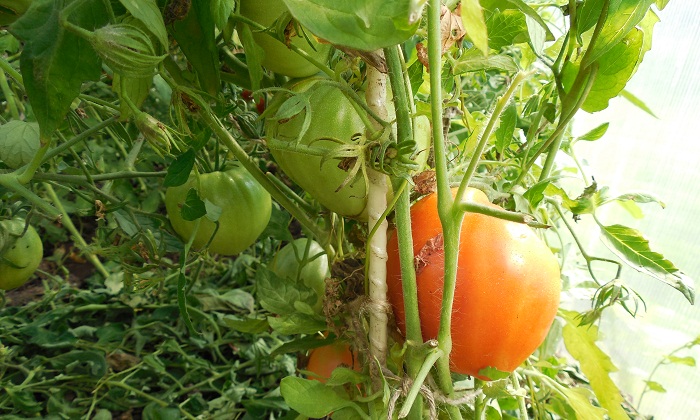 Large-fruited tomatoes, the shape of which resembles the heart, and the color of the fruit is pink, have the best taste. That is what Danko is. These are large, fleshy fruits that have a thin skin, rich aroma and a sweetish taste.
Large-fruited tomatoes, the shape of which resembles the heart, and the color of the fruit is pink, have the best taste. That is what Danko is. These are large, fleshy fruits that have a thin skin, rich aroma and a sweetish taste.
This variety is most suitable for making fresh salads, but it also produces various sauces and pastas. But not only the great taste made Danko famous among gardeners. In addition, he is unpretentious to growing conditions. And suitable for landing in any climate zone.
Content
Variety Characteristics
First of all, it should be noted that Danko does not have a high yield, but its fruiting is stable and does not depend on environmental factors.
Important! This variety is simply impossible not to remember. Its beautiful smooth fruits, reminiscent of a heart, having a raspberry shade, compare favorably with their brothers, who have yellow, red and black shades.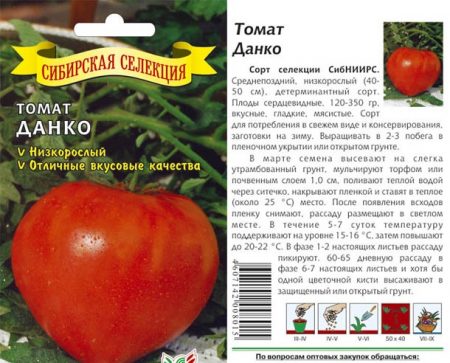
Danko brought breeders of Russia. It belongs to the varieties of Siberian selection. Thanks to this, the tomato perfectly tolerates low temperatures, as well as a lack of sunlight. And it also differs in that the plant is unpretentious to the composition of the soil and temperature fluctuations.
- tomato of a determinant type, that is, the plant has the last growth point;
- bushes are low, only about 50 cm and not too thick;
- suitable for both open ground and greenhouse;
- early ripening tomato. Fruiting begins 110 days after the appearance of the first sprouts;
- the bush is best formed in 3-4 stems. This increases the yield of the plant;
- the bush does not need to remove stepsons, but may require tying;
- this tomato variety tolerates not only cold, but also drought;
- the largest fruits are formed on the lower branches of the bush;
- the fruits are heart-shaped, the surface is slightly ribbed;
- unripe tomatoes have a pale green color. Mature - red-orange. Near the peduncle there is a characteristic green spot;
- the mass of tomatoes differs depending on the method of cultivation, so on beds they can have a weight of -250 g, and in a greenhouse - about 400 g .;
- the fruit has a wonderful taste, sugar pulp, dense, peel have a thin. Therefore, tomatoes of this variety are poorly stored and transported;
- the purpose of the variety is fresh consumption;
- yield is average, about 3-3.5 kg per bush;
- due to their thin skin, tomatoes are prone to cracking;
- resistant to almost all types of diseases that can affect tomatoes;
- have resistance to pests;
- due to the fact that tomatoes of this variety ripen quite early, they rarely suffer from late blight, all because the peak of the disease occurs in August.
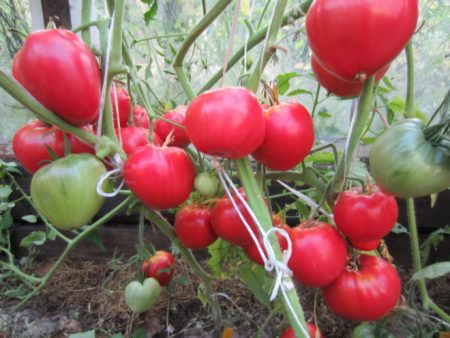
Pros and cons of the variety
Reviews about this variety are most often positive. Its most important quality is universality. Thus, it can be grown throughout Russia.
Grade Advantages:
- great taste;
- excellent external characteristics;
- large fruits;
- small bushes;
- stable yield;
- resistance to "tomato" diseases;
- pest resistance;
- Tomatoes of this variety can bear fruit in any climate zone.It can be heat, drought, excessive dampness, low temperature.
Of course, there were some minuses here.
- Danko, like all pink varieties, is poorly transported;
- not suitable for cultivation on an industrial scale;
- from an excess of moisture in the soil may crack;
- despite the fact that the variety is able to bear fruit in any conditions, but it is worth noting that, under adverse conditions, these indicators will significantly decrease;
- in a greenhouse, it can grow a little taller, so garter may be needed.
Agricultural Techniques
The technology for growing this variety depends on the region, all because the timing of planting plants in the soil will change. And although tomatoes of this variety are considered unpretentious, this does not mean at all that he does not need to pay attention at all.
Landing rules
For regions of Russia, cultivation is exclusively seedling. Therefore, first of all, it is necessary to sow seeds to obtain it.
Sowing dates will also vary by region. For example, in the central regions of the country this is done in early March.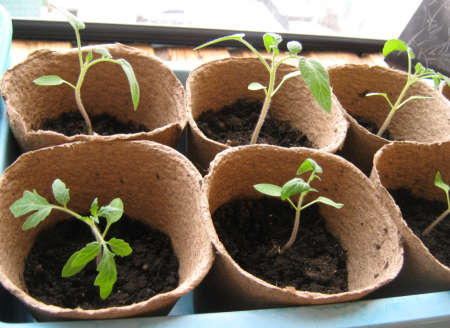
In the event that you have purchased raw planting material, as well as collected it yourself, you must fulfill some conditions:
- rejection of empty seeds;
- warming up;
- processing with a solution of potassium permanganate;
- it is also possible to stimulate the acceleration of the appearance of sprouts with special drugs;
- germinate exclusively in a warm, humid environment.
Sowing of seeds is carried out in loose and nutritious soil. The soil mixture can be purchased in a specialized store, as well as made independently. To do this, take garden soil, mix it with peat or sawdust, add sand, mineral fertilizers, such as phosphorus and potassium.
When the first 2-3 true leaves appear, seedlings should be dived into a large container.
Tomatoes are planted on open beds only when the soil warms up to +10 degrees. It is important that the threat of frost passes. The most optimal scheme is 4 plants per 1 sq.m.
If plants are planned to be planted in the greenhouse, seedlings can be planted around the 20th of May.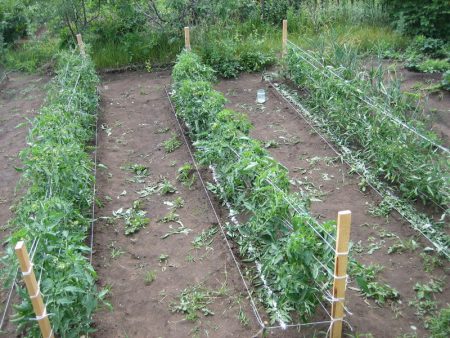
Tomato Care Rules
- Watering is done as the soil dries. The best is considered to be evening watering. Water for this is used warm, preferably settled.
- The plant is formed by removing all stepsons, leaving the first 3-4. If you neglect this rule, you can significantly reduce the yield.
- Top dressing. Approximately 2-3 times during the fruiting season, tomatoes of this variety must be fed. Both organic and mineral fertilizers are suitable for this.
To prevent the occurrence of diseases and pests, the plant should be treated with the product intended for this.
Reviews
Tamara, 43 years old
I’ve been planting tomato Danko at my dacha for more than five years. In general, I am satisfied with the variety. For our harsh climate, the selection of tomato varieties is not too large. Almost all are designed for greenhouse conditions. Tomato pleased me: the fruits are tasty, large.

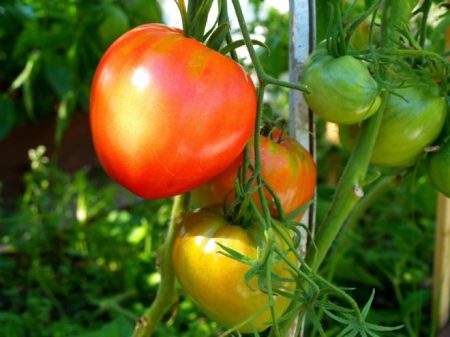



 Low-growing tomatoes, without pinching: 5 of the most delicious varieties
Low-growing tomatoes, without pinching: 5 of the most delicious varieties Why tomato seedlings grow poorly
Why tomato seedlings grow poorly We grow a tomato in a shell
We grow a tomato in a shell Growing tomatoes without watering according to the method of Kazarin
Growing tomatoes without watering according to the method of Kazarin